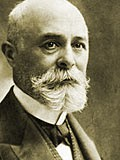
A scant fifty years later, in 1886, Hertz discovers the "outer" photo effect where electrons are completely released from metal surfaces under illumination. He induces his student Hallwachs to experimentally explore the effect, that's why the phenomenon is sometimes called "Hallwachs effect". After Hertz' early death another of his former students, Lenard, takes up the theme and discovers contradictions to the generally accepted wave nature of light, which direct Einstein to formulate his light quantum hypothesis in 1905.
The energy of the electrons released only depends on the frequency, not on the intensity of the incoming light. This holds likewise for the inner photo effect. Einsteins explanation of the outer photo effect becomes thus an essential part of the theoretical basis of modern photovoltaics.
No doubt however, pioneer of this development is Becquerel.
 Scene
Scene


 1st Slide
1st Slide
 Branching Point
Branching Point
 Module: Anwendungen
Module: Anwendungen Sequence: lev0_start
Sequence: lev0_start Branching Point: Applications. The practical heritage
Branching Point: Applications. The practical heritage Slide: Lasers in the industrial fabrication
Slide: Lasers in the industrial fabrication
